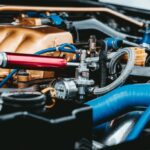The design, construction, and tuning of a competition car’s suspension system are crucial for achieving optimal performance. This guide delves into the theory and practice of successful suspension engineering, exploring how these systems work and providing resources for further learning, including potential PDF downloads.
A well-designed suspension system maximizes tire contact with the track surface, ensuring optimal grip, handling, and stability. This translates to faster lap times and improved driver control. This intricate process involves a delicate balance of various factors, including:
- Geometry: Determining optimal suspension points and angles to control wheel movement and maintain tire contact.
- Components: Selecting appropriate springs, dampers, anti-roll bars, and other components to achieve desired stiffness and damping characteristics.
- Tuning: Fine-tuning spring rates, damper settings, and other parameters to optimize performance for specific track conditions and driving styles.
Key Considerations in Competition Car Suspension Design
Several critical factors influence the design and construction of a competition car suspension:
1. Suspension Type
Different suspension types offer varying performance characteristics. Common types include:
- Double Wishbone: Offers excellent control over wheel movement and camber, often found in high-performance applications.
- MacPherson Strut: A more compact and cost-effective option, commonly used in front suspension systems.
- Pushrod and Pullrod: These systems allow for greater aerodynamic freedom by placing springs and dampers inboard. They are prevalent in Formula One and high-level sports car racing.
Figure: Examples of classic suspension layouts in a 1970 Ferrari 512.
2. Spring and Damper Selection
Choosing the right springs and dampers is vital for achieving desired handling characteristics. Factors to consider include:
- Spring Rate: Determines the stiffness of the suspension and influences ride height and body roll.
- Damping: Controls the rate at which the suspension compresses and rebounds, affecting stability and tire contact.
3. Roll Center and Roll Stiffness
Understanding and controlling the roll center, the point around which the car rolls in corners, is crucial for predictable handling. Roll stiffness, the resistance to body roll, is influenced by spring rates, anti-roll bars, and suspension geometry.
Figure: Diagram illustrating the location of the static roll center in various suspension types.
4. Unsprung Weight
Minimizing unsprung weight—the weight of components not supported by the suspension, such as wheels, tires, and brakes—is essential for responsive handling and improved tire contact.
5. Aerodynamics
Aerodynamic forces significantly impact suspension performance, especially at high speeds. Downforce generated by wings and underbody aerodynamics must be considered when designing and tuning the suspension.
Figure: Comparison of aerodynamic features in a 1970 Porsche 917 and a 1985 Lancia LC2.
Finding Resources: “Competition Car Suspension Design Construction Tuning PDF”
Searching for “Competition Car Suspension Design Construction Tuning Pdf” online may yield various resources, including:
- Textbooks: Books on vehicle dynamics and race car engineering often cover suspension design in detail and may be available in PDF format.
- Technical Papers: Research papers and articles published by universities and professional organizations can provide in-depth analysis of specific suspension concepts.
- Tuning Guides: Guides produced by suspension manufacturers or racing teams might offer practical advice on setting up and tuning competition car suspensions.
By understanding the fundamental principles outlined in this guide and utilizing available resources, aspiring race car engineers and enthusiasts can gain a comprehensive understanding of competition car suspension design, construction, and tuning. Remember to always prioritize safety and consult with experienced professionals when modifying or building a race car. Continuous learning and experimentation are key to mastering this complex and crucial aspect of motorsport engineering.

